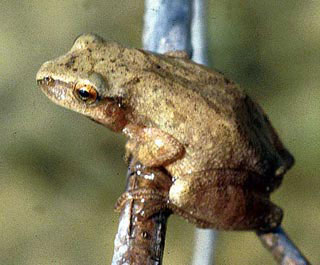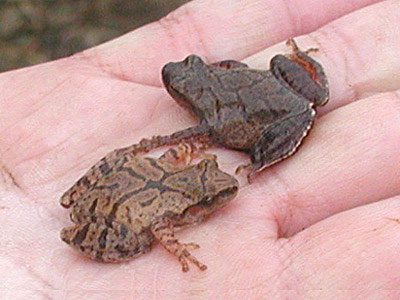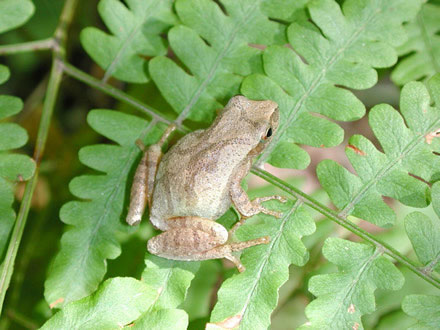Peep, Peep, Peepers
by Dr. Sarah D. Oktay
Managing Director UMass Boston Nantucket Field Station
 One of the most enchanting and keenly awaited sounds on Nantucket is the hesitant “peep” of the first tree frog or spring peeper. In fact, I am listening to their insistent chorus as I write this article. A true harbinger of spring, the male peepers start their mating calls in late March, revving up their motors in April and May, and slowly diminishing in volume as spring turns into summer. Calling is weather dependent and begins as ice melts from the surface of our freshwater ponds, bogs, and vernal pools, and the peepers emerge from their winter hibernation. These are amazing creatures, ideally evolved to live in our cold, wet climate and sing for their mates just in time to remind us that spring is in the air.
One of the most enchanting and keenly awaited sounds on Nantucket is the hesitant “peep” of the first tree frog or spring peeper. In fact, I am listening to their insistent chorus as I write this article. A true harbinger of spring, the male peepers start their mating calls in late March, revving up their motors in April and May, and slowly diminishing in volume as spring turns into summer. Calling is weather dependent and begins as ice melts from the surface of our freshwater ponds, bogs, and vernal pools, and the peepers emerge from their winter hibernation. These are amazing creatures, ideally evolved to live in our cold, wet climate and sing for their mates just in time to remind us that spring is in the air.
According to the excellent Animal Diversity Web site, Pseudacris crucifer, or spring peepers are members of the Hylidae (true tree frogs) family and are native to eastern North American. They are found from southeast Manitoba east to the Atlantic Ocean, and south to eastern Texas and mainland Florida. There are two subspecies of the spring peeper, the Northern (P. c. crucifer) and the Southern spring peeper (P. c. bartramiana). The Northern is similar to the Southern except for a strong dark marking on the Southern frog's belly. The Southern P. c. bartramiana is limited to northern Florida and southern Georgia, while the northern can be found all over the eastern USA and eastern Canada. The southern and northern subspecies also differ in size (slightly) and in clutch size and breeding seasons. The other members of the Pseudacris genus are known as “chorus frogs”.

Spring peepers are tiny, (only 0.75 – 1.3 in. or 2 – 3.5 cm long) and grayish, tan, or olive-brown, with an X-shaped or irregular brown mark on their backs. They have moderately webbed feet and noticeable disks on their fingers and toes. The “X” or cross-like shape on the back is what gave these little guys their species name, “crucifer” which is Latin for “cross bearer.” “Pseudacris” (which would be a great name for a hip-hop artist) is derived from the Greek words “pseudes” or "false" and “akris” meaning "locust." The small size, leaping behavior, and large voice could all add up to a false locust. The credit for naming this species (ca. 1838) goes to Prince Alexander Philipp Maximilian zu Wied-Neuwied who was a German explorer, ethnologist, and naturalist (http://www.answers.com/topic/prince-maximilian-of-wied-neuwied). Prince Maximilian led a fascinating and eventful life and went on to discover several other creatures in Brazil and North America while documenting indigenous people and their culture throughout his travels.
Now that we know who named them, what else do we know about them? Females are lighter-colored, while males are slightly smaller and usually have dark throats. This frog has a vocal sac located by its throat, which expands and deflates like a balloon to create a short and distinct peeping sound. It is truly amazing that such a small creature can emit such a loud noise, measured by scientists to be in the range of 45-85 decibels. To accomplish this feat, the males must have much larger throat muscles than the females; sometimes these muscles are equal to 15% of their body weight. Remember that only males have the ability (or need) to make this loud high-pitched noise. The males will gather at small pools by the hundreds. These pools tend to be near woods and large and permanent enough to support emergent vegetation, but too shallow and temporary to contain fish which would eat the larvae. Each male establishes a small territory by spacing himself just at the edge of the next frog's auditory range (territory size 1.2-5.5 meters squared) and begins calling frequently. This call is described as a shrill "peep" and is known as an “advertising” call because it is broadcast out indiscriminately. The louder and faster he peeps, the better his chances of attracting a receptive female. Males usually compete in trios, and the male with the lowest-pitched call usually starts the vocal competition. During these choruses, the peeps evolve to a trill-like crescendo. I simply had to find a web site with a podcast in case a reader wanted to hear these mini maestros whenever they chose, so go to http://www.podcastdirectory.com/podshows/249495 for an evening chorus of Cape Cod spring peepers.

Females are looking for the largest males and presumably the loudest “peeps.” Spring peepers exhibit size-selective mating which means the larger males breed more frequently. The spring peeper is usually about three years old before it reaches the breeding stage. Research indicates that the females are really looking for the males who have grown bigger faster, not necessarily the oldest males. By the way, in case you want to know, there are several scientific papers out there listing the exact frequencies that female peepers prefer. If you want to study spring peeper breeding behavior related to auditory range and frequencies, you will have to like the sound even more than I do.
These little guys are nocturnal creatures, certainly heard more than seen due to their diminutive size and camouflaged coloring. Their habitat is wet lands, marshes, vernal pools, ponds, or swamps. They need to deposit their eggs in a watery spot in order to support the aquatic environment the larvae need. The spring peeper breeds between the months of March to June, and deposits around 900 eggs (although they can deposit up to 1000) that are hidden under vegetation or debris at the water base. It takes about 1-2 weeks for the tadpoles to emerge from the eggs and then from 2-3 months for them to complete their transformation from tadpoles to frogs.
Pseudacris crucifer is insectivorous, eating mainly small insects including ants, beetles, flies, and spiders. It is believed that food is chosen more by availability and size than by actual preference. At the larva stage, tadpoles feed on algae and other small organisms in the water. Several aquatic invertebrates in vernal pools prey upon the spring peeper tadpole. The hungry predators include the predaceous diving beetle (Family Dytiscidae), leeches (Hirundinea), dragonfly larvae (Odonata) and giant water bugs (Belastoma spp.). In response to the presence of predators, peepers in the larval stage travel short distances in a darting fashion, then remain completely inactive for long periods of time. Predators of the peeper once it is in frog form include snakes, larger frogs (which would be almost all frogs) owls, and salamanders.
Spring peepers produce an antifreeze consisting of low molecular weight cryoprotectants that provide them the ability to survive freezing events. Basically, they allow most of the water in their bodies to freeze while circulating glucose throughout their organs to keep them from forming ice crystals. To adapt to dessication and excess heat, they will burrow under leaves and logs and can survive losing 33% of their water weight before beginning to lose body function. Many scientists have been looking to see if the breeding behavior has moved up in the calendar due to climate change forcing, but so far no significant change in start time has occurred. The mating call is correlated to moisture, rainfall, and temperature and one local scientist is enlisting area naturalists to locate and then record song intensity over the next few weeks of area male spring peepers. If you want to participate in Scott Smyers spring peeper calling intensity study or to learn more about it, please go to www.friendsofwachusett.org/peepers.php.
Spring peepers have a few interesting nicknames, one of which has been sometimes associated with Nantucket (historically recorded, but perhaps erroneously?) when in fact, it is commonly used on a nearby island. On Martha's Vineyard, peepers are commonly called "pinkletinks"; in New Brunswick, Canada, they are called "tinkletoes." In parts of the American South they are referred to as "spring creepers." In western Pennsylvania they are called "peedee dinks."
Sadly Nantucket does not have many of the frog, toad, salamander, and newt species seen on the mainland. Some species like the threatened eastern spadefoot toad once found on Nantucket have been extirpated by chemicals like DDT. The Massachusetts State reptile and amphibian list has the following frog and toad species recorded for Nantucket in addition to Pseudacris crucifer, Ranidae (True Frogs) such as the American Bullfrog Lithobates catesbeianus, Green Frogs Lithobates clamitans, and Pickerel Frogs Lithobates palustris. We'll explore the occurrence and life history of these other frogs in a future column but for now you can see pictures of area tadpoles and frogs at: gallery.cs.umb.edu/gallery/main.php?g2_itemId=374988
I also want to let readers know that the kick off for the Nantucket Family Adventure is Sunday, May 3 from 1-4 at Strong Wings Adventure School. This outdoor family activity is a collaborative effort from island scientific and conservation groups that encourages families to get outside and explore different areas of the island. There will be a variety of free and fun activities like nature walks, rock-wall climbing, Clean Team training, geocaching, and kite building at the kick off and families can compete over 8 weeks to find the most sites and collect the most clues. For more information and to register go to: http://www.mmo.org/education/current-events.html.
To learn more about spring peepers visit the following web sites:
www.amphibiaweb.org
www.mass.gov/dfwele/dfw/wildlife/facts/reptiles/herp_list.htm
animaldiversity.ummz.umich.edu/site/accounts/information/Pseudacris_crucifer.html